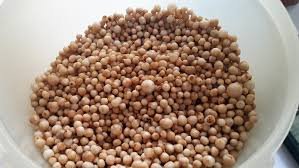Sago

Sago is flour or processed derived from the processing of stalacted stem porch or "sago tree" (Metroxylon sagu Rottb.). Sago flour has physical characteristics similar to tapioca flour. In recipes, relatively difficult to obtain sago flour is often replaced by tapioca flour so that the name is often interchangeable, although the two flours are different.
Sago is a staple food for people in Maluku and Papua who live on the coast. Sago is eaten in the form of papeda, a kind of porridge, or in other preparations. Sago itself is sold as bulk flour or compacted and packed with banana leaves. In addition, sago is also processed into noodles.
As a source of carbohydrates, sago has a uniqueness because it is produced in swamp areas (natural habitat of rumbia). This condition has its own ecological advantages, although it is economically disadvantageous (complicate distribution).
Sago flour is rich in carbohydrates (starch) but very poor in other nutrients. This occurs due to the high content of starch in the stem patio and the harvesting process.
One hundred grams of dried sago is equivalent to 355 calories. In it the average contained 94 grams of carbohydrates, 0.2 grams of protein, 0.5 grams of fiber, 10 mg of calcium, 1.2 mg of iron, and fat, carotene, thiamine, and ascorbic acid in very small quantities.
